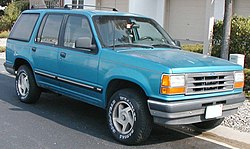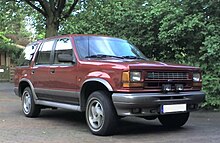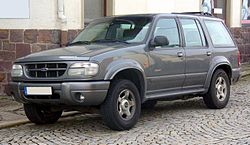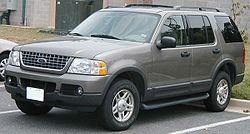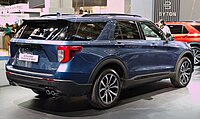Ford Explorer
| Ford Explorer | |
|---|---|
| Production period: | since 1990 |
| Class : | SUV |
| Body versions : | Station wagon |
| Previous model: | Ford Bronco II |
The Ford Explorer is a sport utility vehicle from the American car manufacturer Ford . In Japan and the United States it was also sold as the Mazda Navajo .
First generation (1990–1995)
| 1st generation | |
|---|---|
|
Ford Explorer (1990-1993) |
|
| Production period: | 1990-1995 |
| Body versions : | Station wagon |
| Engines: |
Otto engines : 4.0 liters (116 kW) |
| Length: | 4419-4673 mm |
| Width: | 1778 mm |
| Height: | 1709-1735 mm |
| Wheelbase : | 2593-2842 mm |
| Empty weight : | |
The Ford Explorer has been on sale in the USA since March 15, 1990 .
The Ford Explorer was available in both two-door and four-door versions. It was built on the same box frame and chassis as its predecessor, the Ford Bronco II . At 4.43 meters long and 1.78 meters wide, the Explorer was a lot heavier than the Bronco II, which is why a more powerful engine was necessary. The V6 engine, produced in the Ford engine plant in Cologne in Germany , was revised for this purpose and had a displacement of four liters with approx. 120 kW in the Explorer.
In the equipment list, all options were available to upgrade the Explorer to a luxurious automobile : automatic transmission , touch-drive all-wheel drive system, leather upholstery, air conditioning , stereo system , electric windows and seats, central locking , cruise control, etc.
The breadth of the model range and, associated with it, an equally large target group were an essential cornerstone of its outstanding market success. From the simply equipped two-door Explorer without all-wheel drive with manual transmission as a “ shopping cart ” for the family to the luxuriously equipped luxury vehicle for the stockbroker - there was a suitable model range for all needs.
Europe version
Ford tried to export its successful model to Europe, where the Ford Explorer was offered from 1993 in a European version exclusively with high equipment. In Germany, the Explorer was aimed at the then still small market segment of luxury SUVs. The only engine offered was a 4-liter V6 petrol engine with 121 kW (165 hp). A diesel version was not available.
A curious problem arose with the all-wheel drive: After deactivating the all-wheel drive, the vehicle had to be driven at least one car length against its last direction of travel so that the freewheel hubs were fully unlocked.
In most vehicles, incorrect instructions have been placed behind the left sun visor. This was caused by a wrong translation into German, which often led to damage to the freewheel hubs.
Second generation (1995-2001)
| 2nd generation | |
|---|---|
|
Ford Explorer II (1995-2001) |
|
| Production period: | 1995-2001 |
| Body versions : | Station wagon |
| Engines: |
Petrol engines : 4.0-5.0 liters (116-164 kW) |
| Length: | 4536-4826 mm |
| Width: | 1778 mm |
| Height: | 1702-1735 mm |
| Wheelbase : | 2565-2834 mm |
| Empty weight : | 2001 kg |
The second generation of models started in 1995. The Explorer had been heavily revised from a technical point of view and received a new styling. The total length of the revised Explorer was now 4.78 meters (in the four-door version). In addition to a new, more aerodynamic front section, the interior was also redesigned and the dashboard was adapted to global car standards in terms of ergonomics and design. A new front independent suspension has significantly improved driving comfort. The rear axle with leaf springs , however, remained unchanged. The worm roller steering gear gave way to a more precise rack and pinion steering. The all-wheel drive has also been modernized and now switched on automatically (as a global innovation ) in the event that the rear wheels should lose traction . The four-liter V6 from Cologne , which now developed 115 kW (156 hp), remained largely unchanged .
The new Ford Explorer was an even bigger sales success than the previous model. In the USA and around the world, it became the best-selling off-road vehicle. In the USA, the Explorer was optionally equipped with a 5.0-liter V8 engine (154 kW / 210 PS) from 1996.
In 1997, the 4.0-liter V6 engine with 115 kW (OHV) was supplemented by a more powerful variant (SOHC), which was developed and built in Cologne. With one overhead camshaft per cylinder head, the unit had an output of 152 kW (206 hp) and had the most modern engine management in connection with a further developed automatic transmission with now 5 gears. The basic 115 kW engine was soon discontinued for the German market, but continued to be offered in the USA until 2001. In Germany, the 4.0 liter V6 with 152 kW was predominantly sold.
In 1998 the rear was retouched and in 1999 the front (including round additional headlights in the front bumpers). Basically, the Explorer remained largely unchanged in character during its construction period. Sales in Europe ended in 2001.
Ford attracted attention in 2001 with an affair involving Firestone tires used on the Explorer, which threatened to burst at high speed. There were accidents with a total of more than 174 fatalities and numerous injuries, until Ford reacted and changed the tire make.
Third generation (2001-2005)
| 3rd generation | |
|---|---|
|
Ford Explorer (2001-2005) |
|
| Production period: | 2001-2005 |
| Body versions : | Station wagon |
| Engines: |
Petrol engines : 4.0-4.6 liters (153-225 kW) |
| Length: | 4800 mm |
| Width: | 1828 mm |
| Height: | 1803 mm |
| Wheelbase : | 2888-2890 mm |
| Empty weight : | |
In the fall of 2001, the Explorer experienced another model change in the USA. The third-generation vehicle still had a box frame, but now offered more space and an optional third row of seats.
In addition, the Explorer received a completely new independent suspension and, in terms of the engine range, a revised four-liter V6 engine and a new V8 engine made of light alloy.
Fourth generation (2005-2010)
| 4th generation | |
|---|---|
|
Ford Explorer (2005-2010) |
|
| Production period: | 2005-2010 |
| Body versions : | Station wagon |
| Engines: |
Petrol engines : 4.0-4.6 liters (157-218 kW) |
| Length: | 4902 mm |
| Width: | 1854 mm |
| Height: | 1803-1826 mm |
| Wheelbase : | 2890 mm |
| Empty weight : | |
In late summer 2005 the Ford Explorer got a facelift. The right-hand drive variant for individual export markets (such as Australia) was omitted.
In 2005 and 2006, sales of the Ford Explorer in the USA fell significantly. Instead of the off-road vehicles known as “sport utility vehicles” in the USA, demand shifted to SUVs in the European sense; Called “Crossover Sport Utility Vehicle” in the USA because they offer similar properties to SUVs, but are more compact and lighter and therefore consume less gasoline.
| model | 4.0 V6 | 4.6 V8 |
|---|---|---|
| Number of cylinders | 6th | 8th |
| Displacement (cm³) | 4015 | 4605 |
| Max. Power (kW / PS) | 157/214 at 5100 | 218/296 at 5700 |
| Max. Torque (Nm) | 344 at 3700 | 427 at 4000 |
| Top speed (km / h) | still unknown | still unknown |
| Acceleration (0-100 km / h) | still unknown | still unknown |
| Transmission (standard) | 5-stage automatic | 6-stage automatic |
| Carbon dioxide emissions | 345 g / km | 324 g / km |
| Tank capacity (l) | 85 | 85 |
Fifth generation (2010-2019)
| 5th generation | |
|---|---|
|
Ford Explorer Limited (2010-2015) |
|
| Production period: | 2010-2019 |
| Body versions : | Station wagon |
| Engines: |
Gasoline engines : 2.0-3.7 liters (179-272 kW) |
| Length: | 5019 mm |
| Width: | 1988 mm |
| Height: | 1788 mm |
| Wheelbase : | 2860 mm |
| Empty weight : | |
In December 2010 the fifth generation of the Explorer appeared. In 2012, the Police Interceptor Utility was released based on the Explorer .
The chassis as well as the body have been significantly revised in the new generation of vehicles. The new generation is visibly more aerodynamic and the interior is more spacious. Instead of V8 engines, Ford only offers inline four and V6 petrol engines for the Explorer. The unit has a displacement of 3.5 liters and has an output of 231 kW, fuel consumption should be reduced by 25% compared to the predecessor model - preliminary manufacturer data now speak of 17-25 instead of 14-20 mpg previously . A four-cylinder engine with a displacement of 2.0 liters with 177 kW is to follow. A 3.7 liter V6 petrol engine is installed exclusively in the Police Interceptor Utility.
In 2015 the Ford Explorer was redesigned.
Police Interceptor Utility of the Royal Canadian Mounted Police
Technical specifications
| model | 2.0 Turbo FWD | 3.5 Ti-VCT 4WD | 3.5 FWD / 4WD | 3.5 EcoBoost 4WD | 3.5 twin turbo 4WD | 3.7 Ti-VCT V6 FFV 4WD |
|---|---|---|---|---|---|---|
| Number of cylinders | R4 | V6 | ||||
| Displacement (cm³) | 1999 | 3496 | 3721 | |||
| Max. Power (kW / PS) | 177/240 at 5500 −1 | 183/249 at 6500 −1 | 213/290 at 6500 −1 | 254/345 at 5700 −1 | 268/365 at 5500 −1 | 227/304 at 6500 −1 |
| Max. Torque (Nm) | 365 at 1750–4000 −1 | 346 at 4000 −1 | 343 at 4000 −1 | 475 at 3500 −1 | 473 at 3500 −1 | 378 at 4000 −1 |
| V max (km / h) | 183 | 193 | 211 | |||
| Acceleration 0-100 (s) | 8.7 | 6.4 | ||||
| Transmission (standard) | 6-stage automatic | |||||
| Combined consumption (l / 100 km) | still unknown | 11.0 great | 15.7 great | 12.3 great | still unknown | 11.1 / 14.7 super / E85 |
Sixth generation (since 2019)
| 6th generation | |
|---|---|
| Production period: | since 2019 |
| Body versions : | Station wagon |
| Engines: |
Petrol engines : 2.3–3.0 liters (224–298 kW) Otto hybrid : 3.0–3.3 liters (237–336 kW) |
| Length: | 5049 mm |
| Width: | 2004 mm |
| Height: | 1778 mm |
| Wheelbase : | 3025 mm |
| Empty weight : | 1971-2466 kg |
| Stars in the Euro-NCAP - crash test (2019) |
|
At the North American International Auto Show in January 2019, Ford presented the sixth generation of the Explorer. As the manufacturer announced after some speculation, the model will be offered again on the European market from the end of 2019. A plug-in hybrid version of the SUV had its European premiere at the International Motor Show in September 2019 . In contrast to the North American market, the Explorer is only sold as a plug-in hybrid in Europe. The series has also been built in China for the first time since June 2020. Previously, models sold there were imported from the United States.
The seven-seater shares the platform with the Lincoln Aviator, which was introduced in 2018 .
The plug-in hybrid is powered by a 257 kW (349 PS) three-liter V6 petrol engine with turbocharging and a 74 kW (101 PS) electric motor . Ford specifies the system output as 336 kW (457 hp). The lithium-ion battery has a capacity of 13.1 kWh, which should enable an electric range of 48 km.
The start of series production was overshadowed by several recalls. As a result, fully assembled Explorer models in Chicago were sent to Flat Rock for extended quality control prior to delivery . These issues are cited as the main driver behind Ford Motor Company's earnings decline in the last quarter of 2019.
Technical specifications
| Parameters | 2.3 EcoBoost (1) | 3.0 EcoBoost (1) | 3.0 EcoBoost ST (1) | 3.3 Hybrid (1) | 3.0 EcoBoost PHEV (2) |
|---|---|---|---|---|---|
| Construction period | since 05/2019 | since 09/2019 | |||
| Engine characteristics | |||||
| Engine type | R4 petrol engine | V6 petrol engine | V6 petrol engine + electric motor | ||
| Displacement | 2294 cc | 2956 cc | 3339 cc | 2956 cc | |
| Max. Internal combustion engine power | 224 kW (305 hp) | 272 kW (370 hp) | 298 kW (405 hp) | 213 kW (290 hp) at 6500 rpm | 257 kW (349 hp) at 5750 rpm |
| Max. Electric motor power | - | 32 kW (44 PS) | 74 kW (101 hp) | ||
| System performance | - | 237 kW (322 hp) | 336 kW (457 hp) | ||
| Max. Internal combustion engine torque | 420 Nm | 515 Nm | 563 Nm | 353 Nm at 4000 rpm | |
| Max. Torque electric motor | - | ||||
| System torque | - | 437 Nm | 825 Nm | ||
| Power transmission | |||||
| Drive, as standard | Rear wheel drive | all wheel drive | Rear wheel drive | all wheel drive | |
| Drive, optional | all wheel drive | - | all wheel drive | - | |
| transmission | 10- speed automatic transmission | ||||
| Readings | |||||
| Top speed | k. A. | 230 km / h | k. A. | 230 km / h | |
| Acceleration, 0-100 km / h | k. A. | 6.0 s | |||
| Fuel consumption over 100 km (combined) | 2.9 l super | ||||
| CO 2 emissions (combined) | k. A. | 66 g / km | |||
| Emission standard according to EU classification | k. A. | Euro 6d-TEMP-EVAP-ISC (since 08/2020: Euro 6d-ISC-FCM) |
|||
Web links
Individual evidence
- ↑ 2015 vs. 2016 Ford Explorer: What's the difference? Retrieved September 17, 2016 .
- ^ Ford Explorer. In: euroncap.com. Retrieved November 14, 2019 .
- ↑ a b Torsten Seibt: Ford Explorer Plug-in-Hybrid: Electric 450 PS luxury SUV from 74,000 euros. In: auto-motor-und-sport.de. September 19, 2019, accessed September 23, 2019 .
- ↑ Chris Teague: New Ford Explorer Launches In China To Healthy Demand. In: fordauthority.com. July 26, 2020, accessed on August 6, 2020 .
- ↑ Stefan Leichsenring: Ford Explorer (2019): That costs the large SUV. In: de.motor1.com. September 20, 2019, accessed September 23, 2019 .
- ↑ Phoebe Wall Howard: 2020 Ford Explorer has top secret problems disrupting dealer delivery. In: Detroit Free Press. September 14, 2019, accessed on February 14, 2020 .
- ↑ Michael Wayland: Ford (F) earnings Q4 2019. In: cnbc.com. Retrieved February 14, 2020 .
